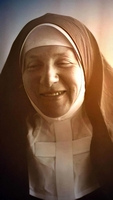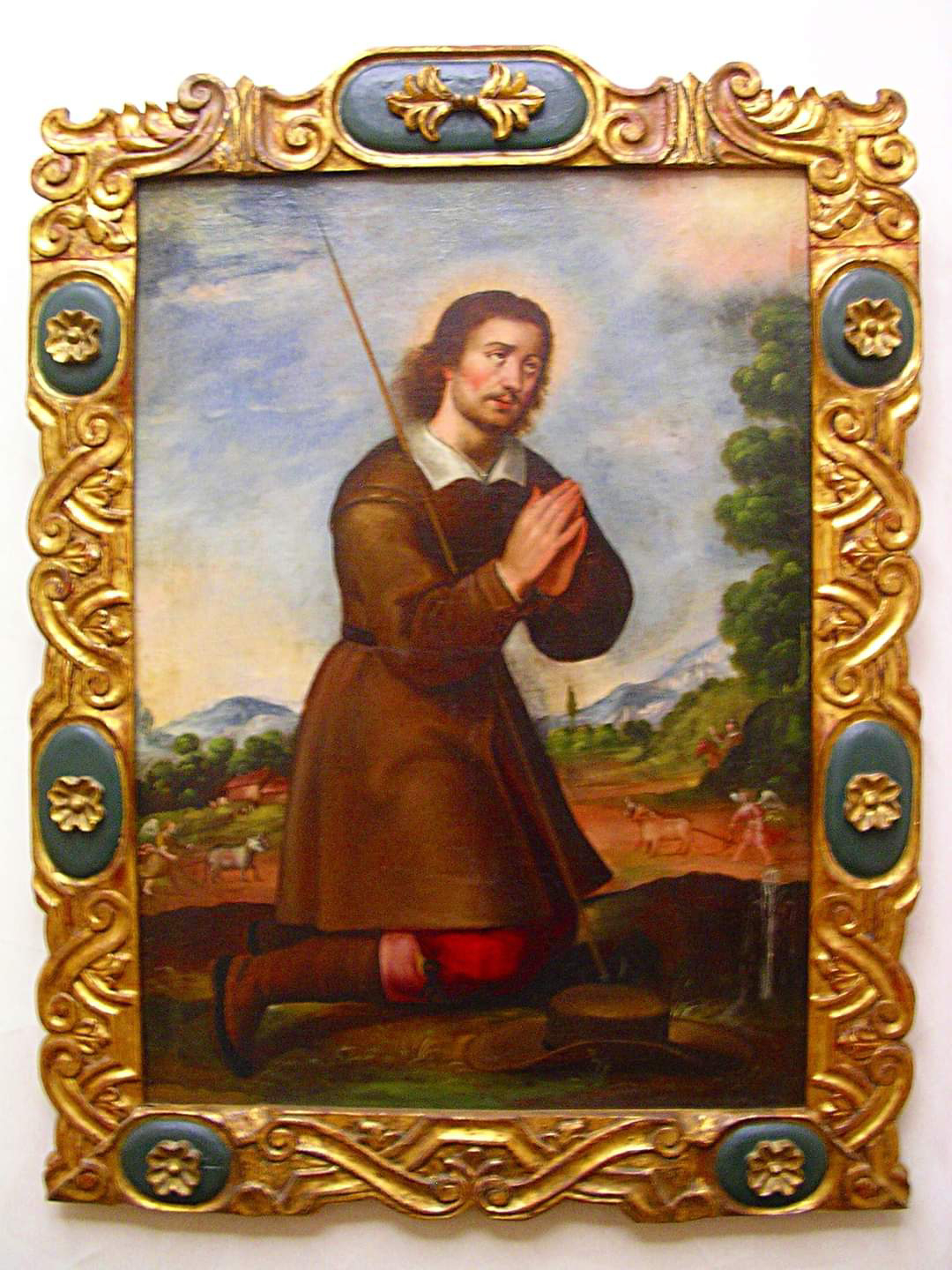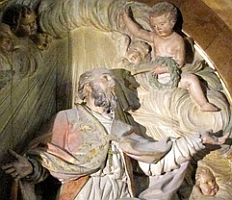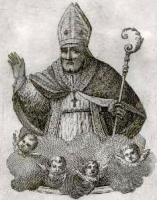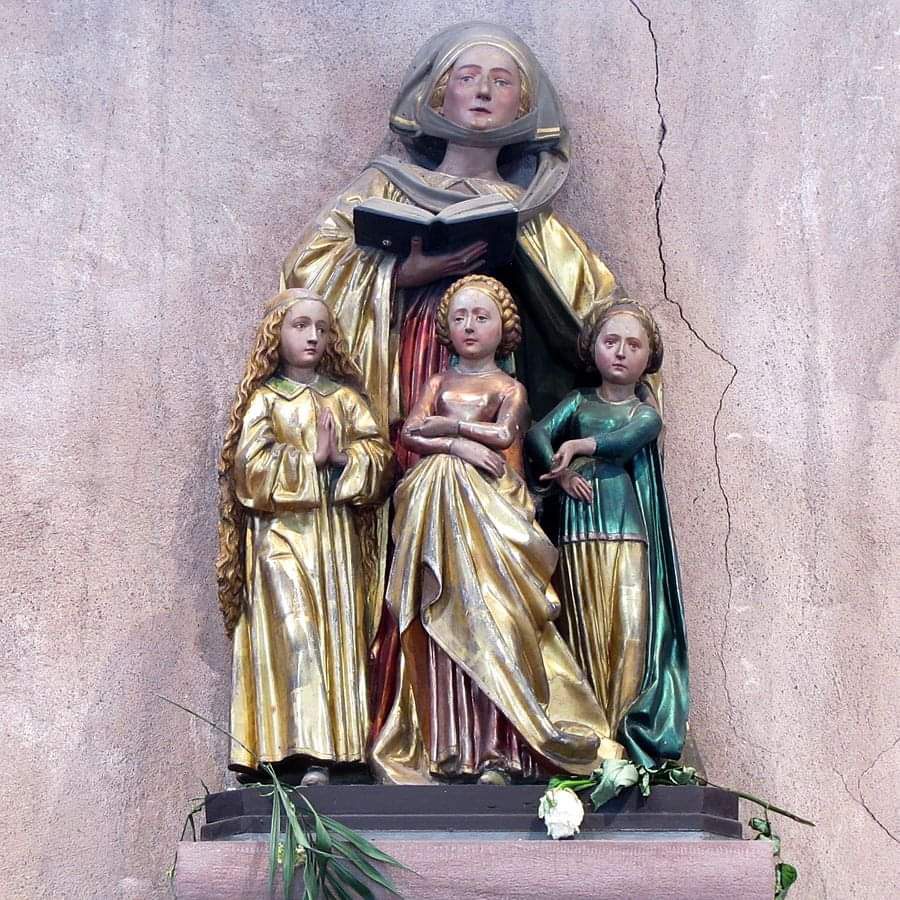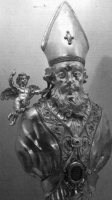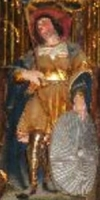St. Peter
Feastday: May 15
Death: 3rd century
Martyr during the brutal persecutions of the Church under Emperor Trajanus Decius. A native of the area around the Hellespont, Peter was put to death at Troas with Sts. Andrew, Dionysia, and Paul.
St. Jeanne de Lestonnac
Feastday: May 15
Patron: of abuse victims, people rejected by religious orders, widows
Birth: 1556
Death: 1640
Image of St. Jeanne de LestonnacIn France, in the XVI century and in Bordeaux, the port at the mouth of the Garonne which became an important centre for Humanism, we approach Jeanne de Lestonnac's life.
Entering her home, we meet Richard de Lestonnac, her father - a counsellor in the Parliament of Bordeaux - and Jeanne Eyquem de Montaigne, her mother. Perhaps Montaigne's name is familiar. You will have heard, maybe, about Michael de Montaigne, the philosopher who wrote the "Essays" and created a new literary genre. He was Jeanne's uncle; they were great friends and his influence can be seen in her work.
Jeanne, the eldest of the Lestonnac - Eyquem de Montaigne family, was born in 1556. During this century a sharp political and religious conflict was raging. The advance of the Protestant Reformation, led by Calvin's followers, clashed with Catholic tradition, and the effects were felt everywhere. While still a child, Jeanne experienced the consequences of the religious differences between her parents. Her father - a fervent Catholic -wished to share his faith with her and had her baptized. Her mother "was convinced that the greatest benefit she could bestow on her daughter was to educate her in the religion of Calvin."
The girl's faith was put to the test and eventually gained from the struggle. Jeanne opted for her father's faith. Her first spiritual experience was as if an interior voice confirmed her choice and left an impression on her for the rest of her life.
"Be careful, daughter. Don't let the fire that I have enkindled in your heart, to serve me so fervently, ever die out."
Her desire to serve the Lord made her search for models of great women, such as St. Scholastica, St. Clare, St. Catherine of Siena, St.Teresa of Avila... but, considering the situation of religious life in France, it was difficult for her to pursue her ideal. When her father proposed that she marry, she took it as a clear sign of God's will.
Jeanne de Lestonnac, O.D.N., (December 27, 1556 – February 2, 1640), alternately known as Joan of Lestonnac, was a Roman Catholic saint and foundress of the Sisters of the Company of Mary, Our Lady, in 1607. The new institute, approved by Paul V in 1607, was the first religious order of women-teachers approved by the Church. Her feast day is May 15.
St. Gerebrand
Feastday: May 15
Death: 7th century
Martyred Irish priest, companion of St. Dymphna. He was quite elderly when he went with St. Dymphna to Belgium, where they were slain by pagans. Gerebrand, sometimes called Gerebern, is patron of a Rhineland area.
St. Dionysia
Feastday: May 15
Death: 1st century
Martyr, who died at the age of sixteen in Lampsacus, Mysia. Dionysia witnessed the trial of three Christians, Nichomacus, Peter, and Andrew. During a torture on the rack, Nichomacus recanted and denied Christ. Dionysia rebuked him for his cowardice and was arrested. She was tortured and turned over to three men for physical assault. An angel halted their advances, and Dionysia escaped. She did not flee the area, but went to the arena where Andrew and Peter hadjust died. There, she demanded martyrdom beside the two saints, but soldiers carried her to another site, where she died by the sword.
St. Caesarn
Feastday: May 15
Virgin recluse at Otranto in southern Italy. To defend her virtue, Cacsarea took refuge in a cave near Otranto. The site became a popular pilgrimage destination.
St. Britwin
Feastday: May 15
Death: 733
Benedictine abbot of Beverley, England, and friend of St. John of Beverley, who became the bishop of York. Britwin did much to foster monasticism and culture in England.
St. Dymphna
Feastday: May 15
Patron: of those suffering for nervous and mental afflictions
Birth: 7th century
Death: 7th century
Canonized: on 620
Dymphna was born in Ireland sometime in the seventh century to a pagan father and devout Christian mother. When she was fourteen, she consecrated herself to Christ and took a vow of chastity. Soon afterward, her mother died and her father - who had loved his wife deeply - began to suffer a rapid deterioration of his mental stability.
So unhinged was Dymphna's father, Damon, that the King's counselors suggested he remarry. Though he was still grieving for his wife, he agreed to remarry if a woman as beautiful as she could be found.
Damon sent messengers throughout his town and other lands to find woman of noble birth who resembled his wife and would be willing to marry him, but when none could be found, his evil advisors whispered sinful suggestions to marry his own daughter. So twisted were Damon's thoughts that he recognized only his wife when he looked upon Dymphna, and so he consented to the arrangement.
When she heard of her father's misguided plot, Dymphna fled her castle with her confessor, a priest named Gerebran, two trusted servants, and the king's fool. The group sailed toward what is now called Belgium, and hid in the town of Geel.
Though it becomes uncertain what exactly happened next, the best-known version claims the group settled in Geel, where Dymphna built a hospital for the poor and sick, but in using her wealth, her father was able to discover her location.
When Damon found his daughter was in Belgium, he traveled to Geel and captured them. He ordered the priest's head to be separated from his body and attempted to convince Dymphna to return to Ireland and marry him.
When Dymphna refused, Damon became enraged and drew his sword. He struck Dymphna's head from her shoulders and left her there. When she died, Dymphna was only fifteen-years-old. After her father left Geel, the residents collected both Dymphna and Gerebran's remains and laid them to rest in a cave.
In defense of her purity, Dymphna received the crown of martyrdom around the year 620 and became known as the "Lily of Éire. In 1349, a church honoring St. Dymphna was built in Geel, and by 1480, so many pilgrims were arriving in need of treatment for mental ills, that the church was expanded. The expanded sanctuary was eventually overflowing again, leaving the townspeople to accept them into their homes, which began a tradition of care for the mentally ill that continues to this day.
Unfortunately, in the 15th century, the original St. Dymphna Church in Geel burned to the ground, and the magnificent Church of St. Dymphna was erected and consecrated in 1532, where it still stands above the location her body was originally buried.
Many miracles have been proven to take place at her shrine in the church erected in her honor, and her remains were placed in a silver reliquary in the church. Some of her remains can also be found at the Shrine to Saint Dymphna in the United States.
The priest who had helped Dymphna was also sainted, and his remains were moved to Xanten, Germany.
The United States National Shrine of Saint Dymphna is at St. Mary's Catholic Church in Massillon, Ohio and St. Dymphna's Special School can be found in ballina, County Mayo, Republic of Ireland.
Saint Dymphna is the patroness of those suffering nervous and mental afflictions as well as victims of incest.
Traditionally, Saint Dymphna is often portrayed with a crown on her head, dressed in royal robes, and holding a sword. In modern art, Saint Dymphna is shown holding the sword, which symbolizes her martyrdom, quite awkwardly. She is also often shown holding a lamp, while some holy cards feature her wearing green and white, holding a book and white lilies.
Prayer:
Hear us, O God, Our Saviour, as we honor St. Dymphna, patron of those afflicted with mental and emotional illness. Help us to be inspired by her example and comforted by her merciful help. Amen.
Saint Dymphna[1] is a Christian saint honoured in Catholic and Orthodox traditions.[2][3] According to tradition, she lived in the 7th century. She was murdered by her father.
The story of St. Dymphna was first recorded in the 13th century by a canon of the Church of St. Aubert at Cambrai, France. It was commissioned by Guiard of Laon (1238–1248), the Bishop of Cambrai.
The author expressly stated that his work was based upon a long-standing oral tradition as well as a persuasive history of miraculous healings of the mentally ill.
St. Torquatus
Feastday: May 15
Patron: of Guadix
Death: 1st century
Christian missionary in Spain, with Ctesiphon, Secundus, Indaletius, Caccilius, Hesychius, and Euphrasius. According to tradition, they were each disciples of the Apostles Peter and Paul and were sent to Spain to spread the faith. The majority of them suffered martyrdom in various parts of the Iberian peninsula, and each is honored on the same feast day; the Mozarabic rite also gives a common feast for them in its liturgy. Torquatus worked in the area around Granada.
Saint Torquatus (Spanish: Santo Torcuato) is venerated as the patron saint of Guadix, Spain. Tradition makes him a Christian missionary of the 1st century, during the Apostolic Age. He evangelized the town of Acci, identified as Guadix, and became its first bishop.
He is one of the group of Seven Apostolic Men (siete varones apostólicos), seven Christian clerics ordained in Rome by Saints Peter and Paul and sent to evangelize the Hispania. Besides Torquatus, this group includes Sts. Hesychius, Caecilius, Ctesiphon, Euphrasius, Indaletius, and Secundius (Isicio, Cecilio, Tesifonte, Eufrasio, Hesiquio y Segundo).
It is not certain whether Torquatus was a martyr or confessor of the faith.[1]
Veneration
The Gate of Saint Torquatus (Puerta de San Torcuato) in Guadix.
Torquatus' relics were rediscovered in the 8th century during the Moorish invasion of Spain, in a church built in his honor, near the Limia River.[1]
Torquatus' relics and those of Euphrasius were translated to Galicia.[2] Torquatus’ relics remained for a long time in the Visigothic church of Santa Comba de Bande (Ourense) (Santa Comba de Baños).
In the 10th century, Torquatus' relics were translated to San Salvador de Celanova (in Celanova, Ourense).[1]
In 1592, the sepulcher at Celanova was opened and part of Torquatus’ relics were distributed to Guadix, Compostela, and Ourense, and also to El Escorial, and to the Jesuit college at Guadix, and in 1627, to Granada.[1] The relics that remained in San Salvador de Celanova were placed in the main chapel of the church of the monastery, together with those of Saint Rudesind, the monastery’s founder.[1]
The cathedral of Guadix conserves three relics associated with Saint Torquatus: his arm, his jawbone, and his calcaneus (this last relic is not on display).[2]
It has been theorized[3] that Torquatus, may be a Christian version of the Celtic god Bandua
Blessed Elzbieta Róza Czacka
Additional Memorial
19 May on some calendars
Profile
The youngest of four children in an aristocratic family who moved from a small town in Ukraine to Warsaw, Poland in 1882. Rosa received a good secular and religious education even as her eyesight deteriorated; in 1898, at age 22, she was completely blind. She spent a lot of time in prayer and in discerning a vocation, and began devoting herself to helping and teaching the blind. In 1909, she and several like-minded friends and co-workers founded a group to start a shelter and school for blind girls to help them live fuller lives on their own.
In 1915 she returned to the Ukraine for the First Communion of a family member – and was stuck there for three years as the escalation of World War I kept her from returning to Warsaw. There she learned of Franciscan spirituality, and in 1916 became a Franciscan tertiary, taking the name Elzbieta.
Returning to Warsaw in 1918, she resumed her work with the neglected blind, and formalized the group of co-workers into the Franciscan Sisters Servants of the Cross, which would receive formal approval in 1922. A supported gave her land in Laski, Poland where she built an institute and school for the blind, and the motherhouse of the Sisters. She received support from Pope Pius XI in 1937, during World War II the Institute was converted to a hospital and the Sisters served as nurses.
This did not last; the Institute was destroyed, and the Sisters returned to Warsaw where Mother Elzbieta was injured in a bombing of the city. The Sisters worked to support the Polish partisans against the Nazis, and Elzbieta worked with Blessed Stefan Wyszynski.
When the war ended, the Sisters returned to their primary mission, and Mother Elzbieta continued to lead them until 1947 when, at age 70, she retired from leadership. She suffered a stroke in 1948 and her health slowly declined, but she spent her remaining 13 years in prayer, contemplation and any service she could provide.
Born
22 October 1876 in Biala Cerkiew, Ukraine as Róza Czacka
Died
15 May 1961 in Laski, Poland after several years of complications from a cerebral hemorrhage in 1948
Beatified
• 12 September 2021 by Pope Francis
• beatification celebrated in Warsaw, Poland presided by Cardinal Marcello Semeraro
• the beatification miracle involved the 13 September 2010 healing of a seven-year-old girl in Warsaw who was in a coma with severe cranial and brain damage from an accident; from the moment of the accident, the Sisters and the family began asking Mother Elzbieta for her intercession
Saint Isidore the Farmer
புனிதர் இஸிடோர்
(St. Isidore the Laborer)
விவசாயிகளின் பாதுகாவல் புனிதர்:
(Patron Saint of Farmers)
பிறப்பு: கி.பி. 1070
மேட்ரிட், கேஸ்டைல் அரசு
(Madrid, Kingdom of Castile)
இறப்பு: மே 15, 1130 (வயது 59)
மேட்ரிட், கேஸ்டைல் அரசு
(Madrid, Kingdom of Castile)
ஏற்கும் சமயம்:
ரோமன் கத்தோலிக்க திருச்சபை
(Roman Catholic Church)
அகில்பயன் திருச்சபை (ஃபிலிப்பைன் நாட்டின் தனி திருச்சபை)
(Aglipayan Church)
முக்திபேறு பட்டம்: மே 2, 1619
திருத்தந்தை ஐந்தாம் பவுல்
(Pope Paul V)
புனிதர் பட்டம்: மார்ச் 12, 1622
திருத்தந்தை பதினைந்தாம் கிரகோரி
(Pope Gregory XV)
நினைவுத் திருநாள்: மே 15
பாதுகாவல்:
மேட்ரிட், விவசாயம், விவசாயி, தினக்கூலி
புனிதர் இஸிடோர் ஒரு ஸ்பேனிஷ் பண்ணைத் தொழிலாளியும் ஏழைகள் மற்றும் கால்நடைகள் மீது கொண்ட அன்பின் காரணமாக நன்கு அறியப்பட்டவரும் ஆவார். இவர் "மேட்ரிட்" (Madrid) நகர் மற்றும் விவசாயிகளின் பாதுகாவல் புனிதர் ஆவார்.
ஸ்பெய்ன் நாட்டின் "மேட்ரிட்" (Madrid) நகரில் சுமார் கி.பி. 1070ம் ஆண்டு ஏழைப் பெற்றோருக்கு மகனாகப் பிறந்த இவர், கிறிஸ்தவ விசுவாசம் மிக்க குடும்பத்தைச் சேர்ந்தவர் ஆவார். இவர், "மேட்ரிட்" நகரின் புறநகர் பகுதியில் "ஜுவான் டி வர்காஸ்" (Juan de Vargas) எனும் பணக்கார நிலச்சுவான்தாரின் பண்ணையில் பண்ணைத் தொழிலாளியாக பணிபுரிந்தார்.
நடுத்தர வயதைக் கடந்த இஸிடோர், "மரியா டொர்ரிபியா" (Maria Torribia) எனும் இளம்பெண்ணை திருமணம் செய்தார். இவர்களுக்கு ஒரு ஆண் குழந்தை பிறந்தது. ஒருமுறை, இவர்களது குழந்தை மிகவும் ஆழமான ஒரு கிணற்றில் தவறி விழுந்துவிட்டது. இஸிடோர் மற்றும் மரியா இருவரும் செய்த செபத்தின் பலனாக கிணற்றின் நீர் மேலெழுந்து குழந்தை மேலே வந்ததாகவும் அது காப்பாற்றப்பட்டதாகவும் கூறப்படுகின்றது. தமது செபத்தினால் குழந்தை பிழைத்துக்கொண்டதற்கு நன்றி கூறும் விதமாக, அவர்களிருவரும் பாலியல் உறவைத் தவிர்ப்பதற்காக தனித்தனி வீடுகளில் வாழ்ந்தனர். அவர்களது மகன் பின்னர் இளம் வயதில் மரித்துப்போனான்.
இஸிடோர் ஏழைகளின் மீதும் கால்நடைகளின் மீதும் மிக்க அன்பு கொண்டவராக இருந்தார். தன்னிடம் உள்ள உணவு எதுவாகினும் அதனை ஏழைகளுக்கு கொடுத்தே தாமும் உண்பார்.
இஸிடோர் கி.பி. 1130ம் ஆண்டு, மே மாதம், 15ம் நாளன்று, மேட்ரிட் நகரினருகே மரித்தார்.
Also known as
• Isadore the Farmer
• Isidore Bonden
• Isidore of Madrid
• Isidore the Laborer
• Isidore the Worker
• Isidro Labrador
Profile
Pious farmer. Married to Saint Mary de la Cabeza. Their son died young; they became convinced it was the will of God that they not have children, and they lived together chastely the rest of their lives, doing good works. Accused by fellow workers of shirking his duties by attending Mass each day, taking time out for prayers, etc. Isidore claimed he had no choice but to follow the highest Master. One tale says that when his master came in the morning to chastise him for skipping work for church, he found angels plowing the fields in place of Isidore. Miracles and cures reported at his grave, in which his body remains incorrupt.
Born
c.1070 at Madrid, Castille (part of modern Spain)
Died
• 15 May 1130 at Madrid, Spain of natural causes
• buried at the Church of San Isidro in Madrid
Canonized
12 March 1622 by Pope Gregory XV
Patronage
• against the death of children
• agricultural workers, farm workers, farmers, field hands, husbandmen, ranchers
• day laborers
• for rain
• livestock
• rural communities
• United States National Rural Life Conference
• World Youth Day 2011
• diocese of Digos, Philippines
• diocese of Malaybalay, Philippines
• 24 cities
Storefront
medals, holy cards, books
Blessed Andrew Abellon
Profile
In his youth he got to listen to the preaching of Saint Vincent Ferrer. Joined the Dominicans at Saint Maximin monastery. Priest. Prior of Saint Mary Magdalen monastery, Provence, France, a noted pilgrimage site; tradition says it is one of the places where Saint Mary Magdalen went after the Crucifixion, and the monastery laid claim to her relics. Supported missionaries and preached home missions. Noted artist in his day, especially known for his manuscript illuminations.
Born
1375 at Saint Maximin, Provence, France
Died
• 15 May 1450 at Aix-en-Provence, France of natural causes
• buried in the Church of the Magdalen
• his tomb became known as a site of miraculous cures
Beatified
1902 by Pope Leo XIII (cultus confirmed)
Patronage
against fever
Saint Euphrasius of Andújar
Also known as
• Euphrasius of Illiturgi
• Euphrasius of Illiturgis
• Euphemia, Eufrasio
• Apostle of Spain
Profile
First century spiritual student of the Apostles. One of the first group of missionaries to Spain, ordained by Saint Peter and Saint Paul. Martyr.
Legend says that he once travelled from Spain to Rome, Italy in 30 minutes in order to help the Pope; he managed the quick trip by bribing a captive goblin with leftover food. He is also reputed to have brought a portrait of the Virgin Mary which had been painted by Saint Luke and given to him by Saint Peter.
Died
• 1st century in Illiturgis, Spain
• church built over his sepulcher in the 7th century
• relics taken to the Mao River valley in the Lugo province of Galacia, Spain ahead of invading Moors
• re-interred in the church of Santa María do Mao, O Incio, Spain
• some relics taken to Ajaccio, Corsica
• some relics taken to the cathedral in Jaén, Spain
Patronage
• diocese of Ajaccio, France
• diocese of Jaén, Spain
• Corsica
• Ajaccio, France
• Andújar, Spain
Saint Hallvard of Oslo
Also known as
• Hallvard Vebjørnsson
• Hallvard of Lier
• Alvard, Alvardo, Halward
Profile
Born to the Norwegian royalty. In 1043, as he was about to cross the Drammenfjord in a boat, a woman ran up to him, begging his help; she claimed she was falsely accused of theft, and feared for her life. Hallvard took her aboard, but the pursuers reached them before he could push off. They demanded he give her up, but he refused, saying the woman swore she was innocent. One of the pursuers shot and killed both Hallvard and the woman with a bow. The mob attached a stone to Hallvard's body and threw it into the sea; it floated, and was later enshrined at Christ Church, Oslo, Norway. Revered as a martyr because he died in defense of innocence, in the best spirit of chivalry.
Born
c.1020
Died
• shot with an arrow c.1043 at Drammen, Drammen kommune, Buskerud fylke, Norway
• buried in the Saint Hallvard Cathedral, Oslo, Oslo kommune, Oslo fylke, Norway
Patronage
• protection of innocence
• protection of virtue
• Oslo, Norway
Saint Severinus of Septempeda
Also known as
Severino
Profile
Brother of Saint Victorinus of Camerino. The two brothers distributed their wealth to the poor in their area, then retired to live as hermits on Monte Nero, Italy. Ordered by Pope Vigilius to become Bishop of Septempeda, an area in the Marches of Ancona, Italy. Severinus was so successful at reviving the faith in his diocese that the town is now known as San Severino Marche in his honour.
Born
Septempeda (modern San Severino Marche, Italy)
Died
• 550 of natural causes
• interred in the cathedral in San Severino Marche, Italy
• relics hidden in the side altar of the cathedral during an incursion by the Goths
• relics taken to the site of his hermitage on Monte Nero, Italy on 3 November 590
• church built there and relics enshrined in 944
• relics hidden from invaders and lost in 1197
• relics re-discovered on 15 May 1576
Patronage
San Severino Marche, Italy
Saint Caesarea of Otranto
Additional Memorial
11 September in Santa Cesarea Terme, Italy; tradition says it's the date she fled her father's house
Profile
Daughter of Louis and Lucrezia. Following the death of her mother, the teenage Caesarea left home to escape the incestuous interests of her father. She consecrated herself to God, and withdrew from the world to live as an anchoress in a cave near Otranto, Italy where she devoted herself to prayer.
Born
14th century
Died
14th century of natural causes
Canonized
• due to her reputation for holiness, a church was soon built at the cave of Caesareo
• cultus known to have been in place in the 17th century
Patronage
• Porto Cesareo, Italy
• Santa Cesarea Terme, Italy
Saint Achilles of Larissa
Also known as
• Achilles of Thessaly
• Achilles the Thaumaturgist
• Achillas, Achillius, Ailus, Achilius
Profile
Born to an imperial Roman patrician family, he received a good education, especially in philosophy. On the death of his parents, he sold all his property, gave the money to the poor, and went on pilgrimage to the Holy Lands and then to Rome, Italy. Bishop of Larissa, Thessaly, Greece. Reported to have attended the first Council of Nicaea. Fought Arianism. Miracle worker.
Born
3rd century in Cappadocia, Asia Minor (in modern Turkey)
Died
• c.331 in Larissa, Thessaly of natural causes
• relics venerated at Presba, Bulgaria since 978
Saint Denysa of Troas
Also known as
Dionysia
Profile
A Christian girl ordered to sacrifice to pagan idols during the persecutions of Decius. She refused and was given over to a house of prostitution to be raped into submission. She fought against her "customers" until exhausted at which point her guardian angel appeared and frightened the men away from her. The next morning she fled the house to the site where a mob had dragged Saint Andrew and Saint Paul of Troas, and began proclaiming her faith. The proconsul had her dragged away and executed. Martyr.
Died
beheaded in Alexandria Troas (in modern Turkey) c.250
Saint Sophia of Rome
புனிதர் சோஃபியா
(St. Sophia of Rome)
மறைசாட்சி:
(Martyr)
பிறப்பு: இத்தாலி
இறப்பு: கி.பி. 137
ரோம்
ஏற்கும் சமயம்:
ரோமன் கத்தோலிக்க திருச்சபை
(Roman Catholic Church)
கிழக்கு மரபுவழி திருச்சபை
(Eastern Orthodox Church)
நினைவுத் திருநாள்: மே 15
புனிதர் சோஃபியா, ஓர் திருமணமான பெண் ஆவார். இவருக்கு 3 பெண் குழந்தைகள் பிறந்தனர். இவரின் முதல் குழந்தையின் பெயர் விசுவாசம் (Faith). இரண்டாவது குழந்தையின் பெயர் நம்பிக்கை (Hope). மூன்றாவது குழந்தையின் பெயர் "கருணை" (Charity).
1 கொரி 13-ல் குறிப்பிடும் இறைவார்த்தைகளை தன் குழந்தைகளுக்கு திருமுழுக்கு பெயராக வைத்தார் சோஃபியா. கிறிஸ்துவை இவர்கள் தங்களின் உயிருக்கும் மேலாக நேசித்தார்கள்.
கி.பி. 117ம் ஆண்டு முதல், கி.பி. 138ம் ஆண்டு வரையான காலகட்டத்தில் "ஹட்ரியான்" (Hadrian) எனும் கொடுங்கோல் அரசனில் ஆட்சி காலத்தில் கிறிஸ்தவ மக்கள் துன்புறுத்தப்பட்டனர்.
கிறிஸ்துவில் கொண்ட விசுவாசத்தினால் சோஃபியாவும் அவரது மூன்று மகள்களும் கொடிய வெறியர்களால் பலவித துன்பத்திற்கு ஆளானார்கள். குழந்தைகள் ஒவ்வொருவரையும் ஒருவர் பின் ஒருவராக கொன்றார்கள். அதன்பின் தாய் சோஃபியாவையும் கொன்றார்கள். சோஃபியாவை வைத்தே, அவரின் கைகளாலேயே தன் குழந்தைகளை கொன்று புதைத்தார்கள். பின்பு சோஃபியாவை குழந்தைகளின் கல்லறையிலேயே வைத்து அவரையும் கொலை செய்தார்கள்.
கி.பி. 778ம் ஆண்டுகளில் இவர்களது கல்லறைகளை ஆல்சேஸ்-ல் (Alsace) உள்ள "எஸ்ச்சாவ்" (Eschau) என்ற ஊரிலிருக்கும் ஒரு பெண்களின் துறவற மடத்திற்கு மாற்றப்பட்டுள்ளதாக வரலாறு கூறுகின்றது. அதன்பிறகு பல்கேரியா (Bulgaria) நாட்டின் தலைநகரை இப்புனிதரின் பெயர் கொண்டு சோஃபியா என்றழைக்கப்பட்டது. பின்னர் ஆறாம் நூற்றாண்டில் புனித சோஃபியாவிற்கென்று ஓர் ஆலயம் கட்டப்பட்டது. பின்னர் கி.பி. 1376-லிருந்து பல்கேரியா நாட்டின் சோஃபியா பேராலயம் மிகவும் புகழ் பெற்று பேசப்படுகின்றது. அதன் மறுபெயராக இவ்வாலயம் Holy Wisdom என்றழைக்கப்படுகின்றது. இவருக்கு பல்கேரியா நாட்டில் 20 மீட்டர் உயரமான ஒரு பெரிய சுரூபம் வைத்து இன்றுவரை வணங்கப்படுகின்றது.
Also known as
• Kalte Sophia
• Cold Sophia
• Wet Sophia
• Sophie. Sofia, Zofia
Profile
Young woman martyred in the persecutions of Diocletian.
Died
• c.304 in Rome, Italy
• buried in the cemetery of Gordianus and Epimachus outside Rome
• some relics enshrined at the convent at Eschau, France by Saint Remigius of Strasbourg in 778
• some relics enshrined at the high altar of the church of San Martino ai Monti in Rome by Pope Sergius II c.845
Patronage
• against late frosts
• for the growth of crops
Saint Gerebernus
Also known as
Genebern, Genebrard, Gerebern, Gereborn, Gerebran, Gerebrand
Profile
Aged 7th century Irish priest who baptized Saint Dympna in her infancy, accompanied her when she fled to Belgium, and died at her side.
Born
Ireland
Died
• beheaded in Gheel, Belgium
• head preserved as a relic at Gheel, Belgium
• relics enshrined at Sonsbeck, Germany where they have been the target of His "holy robbers", thieves who specialized in stealing relics
Patronage
• against fever
• against gout
• Sonsbeck, Germany
Saint Simplicius of Sardinia
Also known as
• Simplicius of Fausania
• Simplicius of Olbia
• Simplicio...
Profile
First bishop of Gallura, Italy. Marytred in the persecutions of Diocletian.
Died
buried alive in 304 in Sardinia, Italy
Patronage
diocese of Tempio-Ampurias, Italy
Saint Adiutor of Campania
Also known as
Adjutor, Adiutore
Profile
Priest in North African. Tortured and exiled by being stick in a boat without a rudder and sent out to sea by the Arian Vandals. The boat landed in the Campania region of southern Italy, and he resumed his ministry with the people there.
Patronage
diocese of Amalfi-Cava de 'Tirreni, Italy
Saint Bertha of Bingen
Also known as
Berta
Profile
Daughter of Pepin II. Married to a pagan. Mother of Saint Rupert of Bingen. Widow. Founded several hospices for the poor. Pilgrim to Rome, Italy. After the pilgrimage, she sold all her possessions, gave away her wealth, and spent the remainder of her life as a prayerful hermitess near Bingen, Germany.
Saint Hilary of Galeata
Also known as
Ellero, Ilaro
Profile
Hermit near the River Ronco, Italy. He and some others hermits joined to build the Galeata monastery; it was later renamed Sant-Ilaro in his honour, and given to the Camaldolese Order.
Died
558 of natural causes
Patronage
Lugo, Italy
Saint Isaias
Profile
Monk at the Monastery of the Caves under the direction of Saint Anthony and Saint Theodosius, founders of the house. Abbot at Saint Demtrius Abbey, Kiev in 1062. Bishop of Rostov in 1077. Evangelist to the unconverted of Rostov, teacher of the converted. Miracle worker.
Born
11th century Kiev, Ukraine
Died
• 1090 of natural causes
• relics enshrined in the Cathedral of Rostov, Russia in 1160
Saint Peter of Lampsacus
Profile
Martyred in the persecutions of Decius for refusing to sacrifice to a statue of Venus.
Died
beheaded c.250 in Lampsacus, Asia Minor
Blessed Joan Montpeó Masip
Profile
Seminarian of the archdiocese of Tarragona, Spain. Martyred in the Spanish Civil War.
Born
31 October 1918 in Borges del Camp, Tarragona, Spain
Died
15 May 1938 in Riudecols, Tarragona, Spain
Beatified
• 13 October 2013 by Pope Francis
• beatification celebrated in Tarragona, Spain
Saint Andrew of Troas
Profile
Christian imprisoned for refusing to sacrifice to pagan idols during the persecutions of Decius. After one night in prison, a mob stirred up by the priests of Diana demanded that he and Saint Paul be turned over to them. The two were scourged, dragged out of town, and murdered. Martyr.
Died
stoned to death in Alexandria Troas (in modern Turkey) c.250
Saint Paul of Troas
Profile
Christian imprisoned for refusing to sacrifice to pagan idols during the persecutions of Decius. After one night in prison, a mob stirred up by the priests of Diana demanded that he and Saint Andrew be turned over to them. The two were scourged, dragged out of town, and murdered. Martyr.
Died
stoned to death in Alexandria Troas (in modern Turkey) c.250
Saint Rupert of Bingen
Profile
Son of Saint Bertha of Bingen. Ninth-century hillside hermit near Bingen, Germany. Died while returning from pilgrimage to Rome, Italy. His hill has since been name Rupertsberg in his honour.
Born
near Mainz, Rhineland Palatinate (in modern Germany)
Saint Alvardo
Profile
Wealthy merchant, and a cousin of King Olaf of Norway. Killed when he defended a woman falsely accused of theft. Martyr.
Born
Norway
Died
• 15 May 1043
• interred in the cathedral of Oslo, Norway
Saint Colman Mc O'Laoighse
Also known as
Columbanus Mc O'Laoighse
Profile
Sixth-century spiritual student of Saint Columba and Saint Fintan of Clonenagh. Founded a monastery in Oughaval, Ireland, and served as its first abbot. A church at Stradbally, Ireland is dedicated to him.
Blessed Clemente of Bressanone
Profile
Franciscan friar minor. Sent to the Pinerolo region to preach against Waldensianism, he brought many back to the faith.
Born
Bressanone, Italy
Died
murdered on 15 May 1655 near San Secondo di Pinerolo, Italy
Saint Rheticus of Autun
Also known as
Rheticius, Reticius, Rhétice
Profile
Bishop of Autun, France c.310. Both Saint Augustine of Hippo and Saint Jerome wrote about him and his knowledge of Scripture.
Born
Gallo-Roman
Died
334 of natural causes
Blessed Diego of Valdieri
Profile
Franciscan friar minor. Sent to the Pinerolo region to preach against Waldensianism, he brought many back to the faith.
Born
Valdieri, Italy
Died
murdered on 15 May 1655 near San Secondo di Pinerolo, Italy
Saint Bercthun of Beverley
Also known as
Bertin, Britwin, Brithwin, Brithun
Profile
Benedictine monk. Spiritual student of Saint John of Beverley. First abbot of Beverley in England.
Died
733
Saint Nicholas the Mystic
Profile
Patriarch of Constantinople. Deposed and exiled by emperor Leo VI when he opposed the emperor’s fourth marriage, which was prohibited by the laws of the Eastern Church.
Saint Hesychius of Gibraltar
Profile
First century spiritual student of the Apostles. One of the first group of missionaries to Spain. Marytr.
Saint Victorinus of Clermont
Profile
Convert. Martyred by Teutonic barbarians led by Chrocas.
Died
c.264 in Clermont, France
Saint Caecilius of Granada
Profile
First century spiritual student of the Apostles. One of the first group of missionaries to Spain.
Saint Cassius of Clermont
Profile
Priest. Martyred by Teutonic barbarians led by Chrocas.
Died
c.264 in Clermont, France
Saint Ctesiphon of Verga
Profile
First century spiritual student of the Apostles. One of the first group of missionaries to Spain.
Saint Indaletius of Urci
Profile
First century spiritual student of the Apostles. One of the first group of missionaries to Spain.
Saint Maximus of Clermont
Profile
Martyred by Teutonic barbarians led by Chrocas.
Died
c.264 in Clermont, France
Saint Secundus of Avila
Profile
First century spiritual student of the Apostles. One of the first group of missionaries to Spain.
Saint Waldalenus of Bèze
Profile
Brother of Saint Adalsindis. Founded the monastery of Bèze, France.
Martyrs of Maleville
Profile
50 Mercedarian friars murdered for their faith by Huguenots.
Died
1563 in the Mercedarian convent of Maleville in Rodez, France
Martyrs of Pavia
Profile
Three Christians who were martyred together. We have no other information about them but the names Boninus, Paolinus and Saterius.
Died
• Pavia, Italy, date unknown
• relics enshrined in the church of Saints Gervasio and Protasio in Pavia
Marytrs of Persia
Profile
Three Christians who were tortured, mutilated, imprisoned, starved and finally executed together for refusing to worship the sun and fire during the persecutions of Shapur II. We know nothing else about them but their names - Bohtiso, Isaac and Simeon.
Died
beheaded or burned at the stake (records vary) in the late 3rd century somewhere in Persia




























